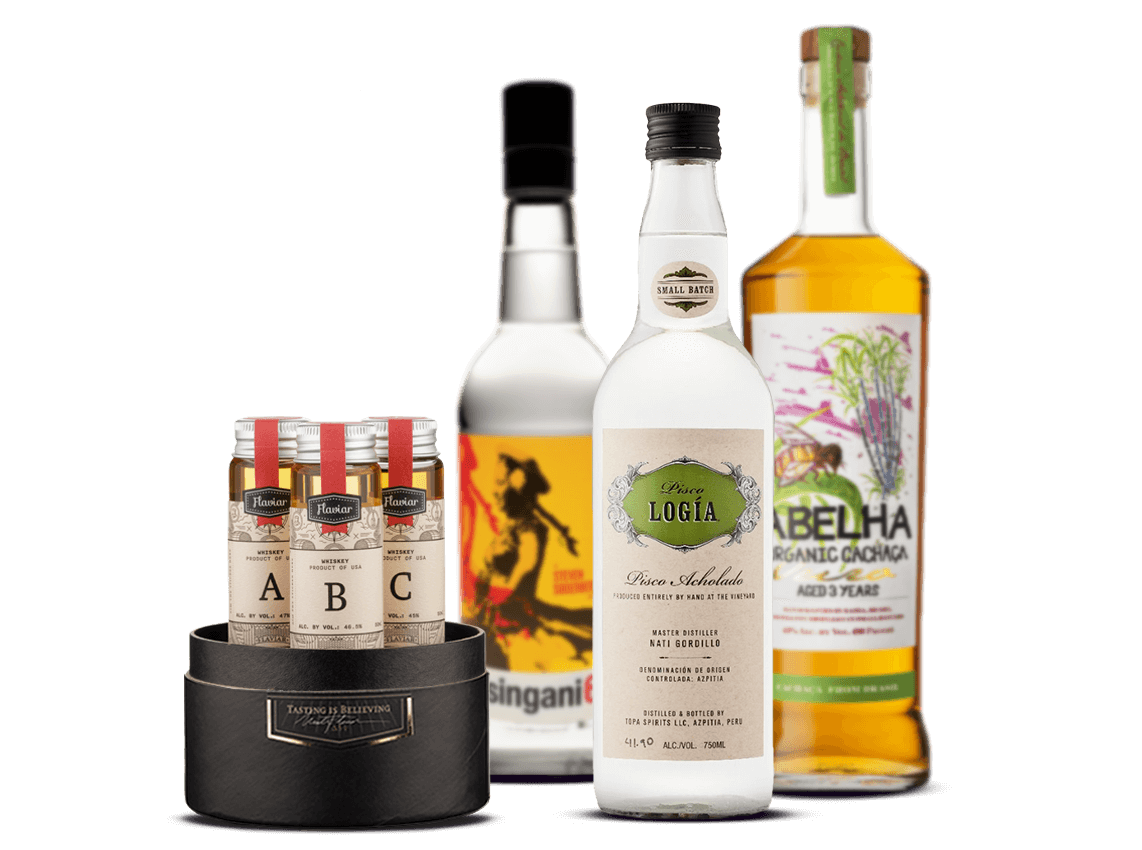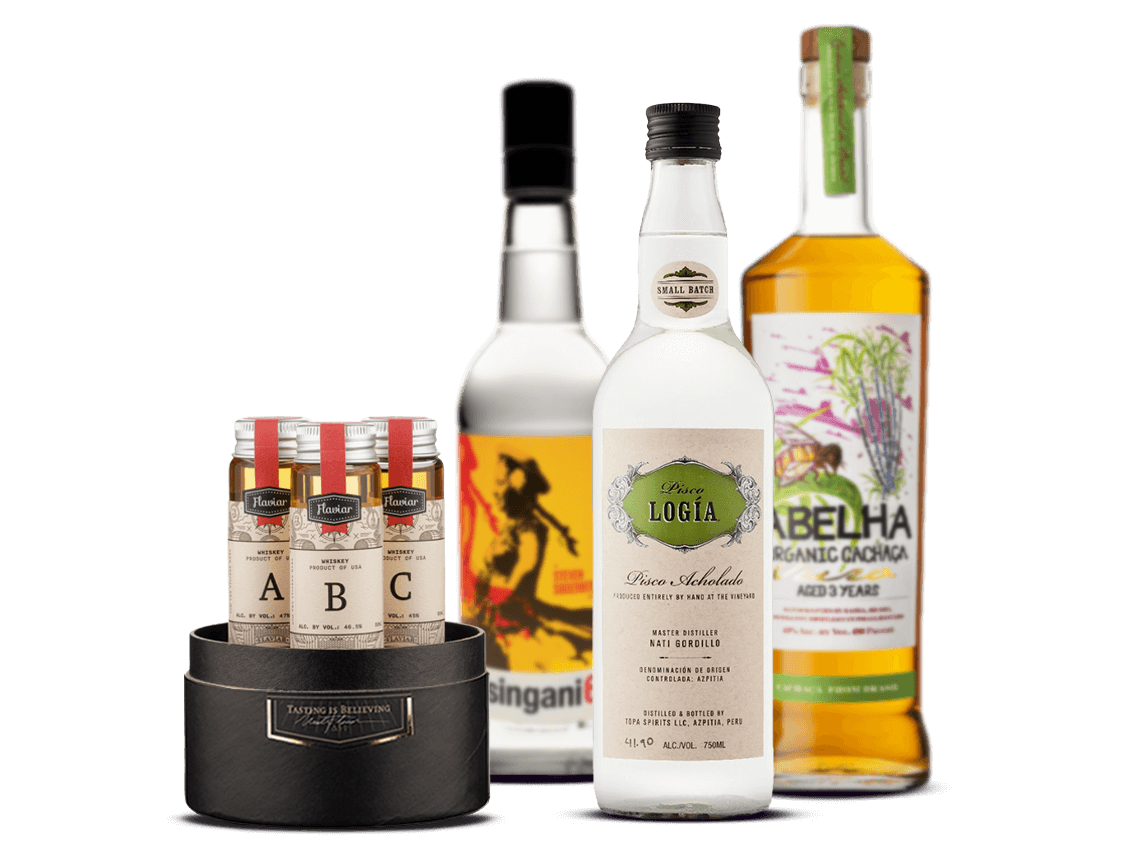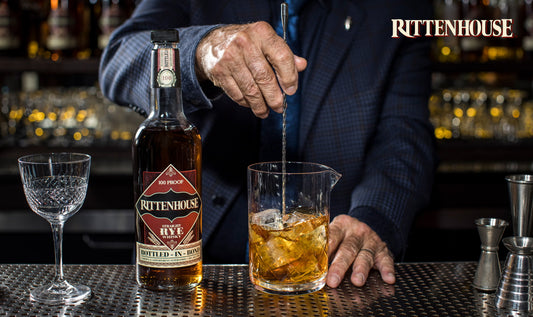Special Price
The Spirit Of South America
The Spirit Of South America
Regular price
$46.99
Members' price
$42.29
(−10%)
Register for free and get 10% off Tasting Box purchases.
Already a Member?
Sign in to purchase.
Quantity
View full details
Couldn't load pickup availability
- CategoryOther Spirits
You know I love it when you call me señorita
I wish it wasn't so damn hard to leave ya
But every touch is ooh-la-la-la
It's true, la-la-la
Ooh, I should be runnin'
Ooh, you keep me coming for ya
Oh yes, the legend of the Latin lover translates far and wide. Magnetic. Enigmatic. Irresistibly charming. The more you try to fight it, the harder it becomes to ignore. Because down south, passion runs hot, and the Spirits birthed from these lands know how to turn heads and break hearts.
Don’t say we didn’t warn you...
Down in Brazil, they’re just crazy about Cachaça. A distilled Spirit made from fermented sugarcane juice, it’s earned many nicknames like abre-coração (heart-opener), bafo-de-tigre (tiger breath), and Brazilian Rum. Chances are you’ve already tasted it if you’ve ever had a true caipirinha, but there’s as many ways to enjoy it as there are names for it.
Over in Peru, it’s Pisco that reigns supreme. This fermented grape juice is technically considered a Brandy, and there are strict rules about aging it in wood barrels (basically, you can’t). It’s also the country’s official Spirit, and like Wine, the flavor profile is all over the place depending on the brand.
In Bolivia, it’s all about Singani. Close kin to Pisco, it stands out for only using one grape: white Muscat of Alexandria. And it’s a completely homegrown Spirit — the grapes are grown and picked in Bolivia, and the Spirit is distilled, bottled and labeled in Bolivia. It’s the country’s oldest liquor and marries floral, fruity and spicy notes for a crazy unique flavor.
In this Tasting Box, you’ll be able to explore the Spirits of South America — beyond Tequila. Hell, you might even find a new favorite. Here’s your line up:
Singani 63
Pisco Logia Acholado
Abelha Organic Cachaça Ouro
And if you can’t be with the one you love, love the Spirit you’re with. Salud!
Smartass Corner:
1) Cachaça has been around for over 400 years and it’s earned many-a-nickname in this time. There’s over 2000 words to depict Cachaça and some of them were coined during the period when it used to be banned in Brazil. The list includes but is not limited to: abre-coração (heart-opener), água-benta (holy water), bafo-de-tigre (tiger breath), limpa-olho (eye-wash), pinga and caninha.
2) While Rum is usually made from molasses, Cachaça is made from fresh sugarcane juice that’s fermented and distilled, similarly to the Rhum agricole from the French Caribbean.
3) Bolivia has a rockin’ eco-system. In fact, 40% of all animal and plant life on the planet can be found there.
4) Most Bolivians drink Singani on the rocks with lime (or with ginger ale and lime), but the Spirit can sub in for Tequila in a wicked good Margarita.
5) One of the best ways to enjoy Pisco? A Pisco Sour, naturally. Peru’s even dedicated a national day to the popular cocktail — the first Saturday of every February is the official Día del Pisco Sour (Pisco Sour Day). National Pisco Day falls on the fourth Saturday of July.
6) There’s a contentious battle over who has the bragging rights to Pisco’s creation. Peru and Chile have fought over it for years, and the world is divided. While the U.S. is indifferent, the EU sides with Peru. That’s why when you drink Pisco in the EU, you can be absolutely sure that it hails from Peru.
I wish it wasn't so damn hard to leave ya
But every touch is ooh-la-la-la
It's true, la-la-la
Ooh, I should be runnin'
Ooh, you keep me coming for ya
Oh yes, the legend of the Latin lover translates far and wide. Magnetic. Enigmatic. Irresistibly charming. The more you try to fight it, the harder it becomes to ignore. Because down south, passion runs hot, and the Spirits birthed from these lands know how to turn heads and break hearts.
Don’t say we didn’t warn you...
Down in Brazil, they’re just crazy about Cachaça. A distilled Spirit made from fermented sugarcane juice, it’s earned many nicknames like abre-coração (heart-opener), bafo-de-tigre (tiger breath), and Brazilian Rum. Chances are you’ve already tasted it if you’ve ever had a true caipirinha, but there’s as many ways to enjoy it as there are names for it.
Over in Peru, it’s Pisco that reigns supreme. This fermented grape juice is technically considered a Brandy, and there are strict rules about aging it in wood barrels (basically, you can’t). It’s also the country’s official Spirit, and like Wine, the flavor profile is all over the place depending on the brand.
In Bolivia, it’s all about Singani. Close kin to Pisco, it stands out for only using one grape: white Muscat of Alexandria. And it’s a completely homegrown Spirit — the grapes are grown and picked in Bolivia, and the Spirit is distilled, bottled and labeled in Bolivia. It’s the country’s oldest liquor and marries floral, fruity and spicy notes for a crazy unique flavor.
In this Tasting Box, you’ll be able to explore the Spirits of South America — beyond Tequila. Hell, you might even find a new favorite. Here’s your line up:
Singani 63
Pisco Logia Acholado
Abelha Organic Cachaça Ouro
And if you can’t be with the one you love, love the Spirit you’re with. Salud!
Smartass Corner:
1) Cachaça has been around for over 400 years and it’s earned many-a-nickname in this time. There’s over 2000 words to depict Cachaça and some of them were coined during the period when it used to be banned in Brazil. The list includes but is not limited to: abre-coração (heart-opener), água-benta (holy water), bafo-de-tigre (tiger breath), limpa-olho (eye-wash), pinga and caninha.
2) While Rum is usually made from molasses, Cachaça is made from fresh sugarcane juice that’s fermented and distilled, similarly to the Rhum agricole from the French Caribbean.
3) Bolivia has a rockin’ eco-system. In fact, 40% of all animal and plant life on the planet can be found there.
4) Most Bolivians drink Singani on the rocks with lime (or with ginger ale and lime), but the Spirit can sub in for Tequila in a wicked good Margarita.
5) One of the best ways to enjoy Pisco? A Pisco Sour, naturally. Peru’s even dedicated a national day to the popular cocktail — the first Saturday of every February is the official Día del Pisco Sour (Pisco Sour Day). National Pisco Day falls on the fourth Saturday of July.
6) There’s a contentious battle over who has the bragging rights to Pisco’s creation. Peru and Chile have fought over it for years, and the world is divided. While the U.S. is indifferent, the EU sides with Peru. That’s why when you drink Pisco in the EU, you can be absolutely sure that it hails from Peru.
About
You know I love it when you call me señorita
I wish it wasn't so damn hard to leave ya
But every touch is ooh-la-la-la
It's true, la-la-la
Ooh, I should be runnin'
Ooh, you keep me coming for ya
Oh yes, the legend of the Latin lover translates far and wide. Magnetic. Enigmatic. Irresistibly charming. The more you try to fight it, the harder it becomes to ignore. Because down south, passion runs hot, and the Spirits birthed from these lands know how to turn heads and break hearts.
Don’t say we didn’t warn you...
Down in Brazil, they’re just crazy about Cachaça. A distilled Spirit made from fermented sugarcane juice, it’s earned many nicknames like abre-coração (heart-opener), bafo-de-tigre (tiger breath), and Brazilian Rum. Chances are you’ve already tasted it if you’ve ever had a true caipirinha, but there’s as many ways to enjoy it as there are names for it.
Over in Peru, it’s Pisco that reigns supreme. This fermented grape juice is technically considered a Brandy, and there are strict rules about aging it in wood barrels (basically, you can’t). It’s also the country’s official Spirit, and like Wine, the flavor profile is all over the place depending on the brand.
In Bolivia, it’s all about Singani. Close kin to Pisco, it stands out for only using one grape: white Muscat of Alexandria. And it’s a completely homegrown Spirit — the grapes are grown and picked in Bolivia, and the Spirit is distilled, bottled and labeled in Bolivia. It’s the country’s oldest liquor and marries floral, fruity and spicy notes for a crazy unique flavor.
In this Tasting Box, you’ll be able to explore the Spirits of South America — beyond Tequila. Hell, you might even find a new favorite. Here’s your line up:
Singani 63
Pisco Logia Acholado
Abelha Organic Cachaça Ouro
And if you can’t be with the one you love, love the Spirit you’re with. Salud!
Smartass Corner:
1) Cachaça has been around for over 400 years and it’s earned many-a-nickname in this time. There’s over 2000 words to depict Cachaça and some of them were coined during the period when it used to be banned in Brazil. The list includes but is not limited to: abre-coração (heart-opener), água-benta (holy water), bafo-de-tigre (tiger breath), limpa-olho (eye-wash), pinga and caninha.
2) While Rum is usually made from molasses, Cachaça is made from fresh sugarcane juice that’s fermented and distilled, similarly to the Rhum agricole from the French Caribbean.
3) Bolivia has a rockin’ eco-system. In fact, 40% of all animal and plant life on the planet can be found there.
4) Most Bolivians drink Singani on the rocks with lime (or with ginger ale and lime), but the Spirit can sub in for Tequila in a wicked good Margarita.
5) One of the best ways to enjoy Pisco? A Pisco Sour, naturally. Peru’s even dedicated a national day to the popular cocktail — the first Saturday of every February is the official Día del Pisco Sour (Pisco Sour Day). National Pisco Day falls on the fourth Saturday of July.
6) There’s a contentious battle over who has the bragging rights to Pisco’s creation. Peru and Chile have fought over it for years, and the world is divided. While the U.S. is indifferent, the EU sides with Peru. That’s why when you drink Pisco in the EU, you can be absolutely sure that it hails from Peru.
I wish it wasn't so damn hard to leave ya
But every touch is ooh-la-la-la
It's true, la-la-la
Ooh, I should be runnin'
Ooh, you keep me coming for ya
Oh yes, the legend of the Latin lover translates far and wide. Magnetic. Enigmatic. Irresistibly charming. The more you try to fight it, the harder it becomes to ignore. Because down south, passion runs hot, and the Spirits birthed from these lands know how to turn heads and break hearts.
Don’t say we didn’t warn you...
Down in Brazil, they’re just crazy about Cachaça. A distilled Spirit made from fermented sugarcane juice, it’s earned many nicknames like abre-coração (heart-opener), bafo-de-tigre (tiger breath), and Brazilian Rum. Chances are you’ve already tasted it if you’ve ever had a true caipirinha, but there’s as many ways to enjoy it as there are names for it.
Over in Peru, it’s Pisco that reigns supreme. This fermented grape juice is technically considered a Brandy, and there are strict rules about aging it in wood barrels (basically, you can’t). It’s also the country’s official Spirit, and like Wine, the flavor profile is all over the place depending on the brand.
In Bolivia, it’s all about Singani. Close kin to Pisco, it stands out for only using one grape: white Muscat of Alexandria. And it’s a completely homegrown Spirit — the grapes are grown and picked in Bolivia, and the Spirit is distilled, bottled and labeled in Bolivia. It’s the country’s oldest liquor and marries floral, fruity and spicy notes for a crazy unique flavor.
In this Tasting Box, you’ll be able to explore the Spirits of South America — beyond Tequila. Hell, you might even find a new favorite. Here’s your line up:
Singani 63
Pisco Logia Acholado
Abelha Organic Cachaça Ouro
And if you can’t be with the one you love, love the Spirit you’re with. Salud!
Smartass Corner:
1) Cachaça has been around for over 400 years and it’s earned many-a-nickname in this time. There’s over 2000 words to depict Cachaça and some of them were coined during the period when it used to be banned in Brazil. The list includes but is not limited to: abre-coração (heart-opener), água-benta (holy water), bafo-de-tigre (tiger breath), limpa-olho (eye-wash), pinga and caninha.
2) While Rum is usually made from molasses, Cachaça is made from fresh sugarcane juice that’s fermented and distilled, similarly to the Rhum agricole from the French Caribbean.
3) Bolivia has a rockin’ eco-system. In fact, 40% of all animal and plant life on the planet can be found there.
4) Most Bolivians drink Singani on the rocks with lime (or with ginger ale and lime), but the Spirit can sub in for Tequila in a wicked good Margarita.
5) One of the best ways to enjoy Pisco? A Pisco Sour, naturally. Peru’s even dedicated a national day to the popular cocktail — the first Saturday of every February is the official Día del Pisco Sour (Pisco Sour Day). National Pisco Day falls on the fourth Saturday of July.
6) There’s a contentious battle over who has the bragging rights to Pisco’s creation. Peru and Chile have fought over it for years, and the world is divided. While the U.S. is indifferent, the EU sides with Peru. That’s why when you drink Pisco in the EU, you can be absolutely sure that it hails from Peru.
Read More
- CategoryOther Spirits
Whats in the box?
Flaviar Tasting Box
What is it made of?



























